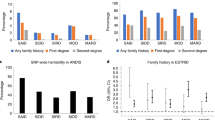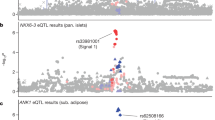Abstract
Type 2 diabetes mellitus results from the interaction of environmental factors with a combination of genetic variants, most of which were hitherto unknown. A systematic search for these variants was recently made possible by the development of high-density arrays that permit the genotyping of hundreds of thousands of polymorphisms. We tested 392,935 single-nucleotide polymorphisms in a French case–control cohort. Markers with the most significant difference in genotype frequencies between cases of type 2 diabetes and controls were fast-tracked for testing in a second cohort. This identified four loci containing variants that confer type 2 diabetes risk, in addition to confirming the known association with the TCF7L2 gene. These loci include a non-synonymous polymorphism in the zinc transporter SLC30A8, which is expressed exclusively in insulin-producing β-cells, and two linkage disequilibrium blocks that contain genes potentially involved in β-cell development or function (IDE–KIF11–HHEX and EXT2–ALX4). These associations explain a substantial portion of disease risk and constitute proof of principle for the genome-wide approach to the elucidation of complex genetic traits.
This is a preview of subscription content, access via your institution
Access options
Subscribe to this journal
Receive 51 print issues and online access
$199.00 per year
only $3.90 per issue
Buy this article
- Purchase on Springer Link
- Instant access to full article PDF
Prices may be subject to local taxes which are calculated during checkout


Similar content being viewed by others
References
Permutt, M. A., Wasson, J. & Cox, N. Genetic epidemiology of diabetes. J. Clin. Invest. 115, 1431–1439 (2005)
Horikawa, Y. et al. Genetic variation in the gene encoding calpain-10 is associated with type 2 diabetes mellitus. Nature Genet. 26, 163–175 (2000)
Meyre, D. et al. Variants of ENPP1 are associated with childhood and adult obesity and increase the risk of glucose intolerance and type 2 diabetes. Nature Genet. 37, 863–867 (2005)
Love-Gregory, L. D. et al. A common polymorphism in the upstream promoter region of the hepatocyte nuclear factor-4α gene on chromosome 20q is associated with type 2 diabetes and appears to contribute to the evidence for linkage in an ashkenazi jewish population. Diabetes 53, 1134–1140 (2004)
Silander, K. et al. Genetic variation near the hepatocyte nuclear factor-4α gene predicts susceptibility to type 2 diabetes. Diabetes 53, 1141–1149 (2004)
Vasseur, F. et al. Single-nucleotide polymorphism haplotypes in the both proximal promoter and exon 3 of the APM1 gene modulate adipocyte-secreted adiponectin hormone levels and contribute to the genetic risk for type 2 diabetes in French Caucasians. Hum. Mol. Genet. 11, 2607–2614 (2002)
Altshuler, D. et al. The common PPARγ Pro12Ala polymorphism is associated with decreased risk of type 2 diabetes. Nature Genet. 26, 76–80 (2000)
Gloyn, A. L. et al. Large-scale association studies of variants in genes encoding the pancreatic β-cell KATP channel subunits Kir6.2 (KCNJ11) and SUR1 (ABCC8) confirm that the KCNJ11 E23K variant is associated with type 2 diabetes. Diabetes 52, 568–572 (2003)
Grant, S. F. et al. Variant of transcription factor 7-like 2 (TCF7L2) gene confers risk of type 2 diabetes. Nature Genet. 38, 320–323 (2006)
Zhang, C. et al. Variant of transcription factor 7-like 2 (TCF7L2) gene and the risk of type 2 diabetes in large cohorts of U.S. women and men. Diabetes 55, 2645–2648 (2006)
Damcott, C. M. et al. Polymorphisms in the transcription factor 7-like 2 (TCF7L2) gene are associated with type 2 diabetes in the Amish: replication and evidence for a role in both insulin secretion and insulin resistance. Diabetes 55, 2654–2659 (2006)
Scott, L. J. et al. Association of transcription factor 7-like 2 (TCF7L2) variants with type 2 diabetes in a Finnish sample. Diabetes 55, 2649–2653 (2006)
Groves, C. J. et al. Association analysis of 6,736 U.K. subjects provides replication and confirms TCF7L2 as a type 2 diabetes susceptibility gene with a substantial effect on individual risk. Diabetes 55, 2640–2644 (2006)
Cauchi, S. et al. TCF7L2 variation predicts hyperglycemia incidence in a French general population: the data from an epidemiological study on the Insulin Resistance Syndrome (DESIR) study. Diabetes 55, 3189–3192 (2006)
Chandak, G. R. et al. Common variants in the TCF7L2 gene are strongly associated with type 2 diabetes mellitus in the Indian population. Diabetologia 50, 63–67 (2007)
Florez, J. C. et al. TCF7L2 polymorphisms and progression to diabetes in the Diabetes Prevention Program. N. Engl. J. Med. 355, 241–250 (2006)
Humphries, S. E. et al. Common variants in the TCF7L2 gene and predisposition to type 2 diabetes in UK European whites, Indian Asians and Afro-Caribbean men and women. J. Mol. Med. 84, 1–10 (2006)
Parton, L. E. et al. Limited role for SREBP-1c in defective glucose-induced insulin secretion from Zucker diabetic fatty rat islets: a functional and gene profiling analysis. Am. J. Physiol. Endocrinol. Metab. 291, E982–E994 (2006)
Saxena, R. et al. Common single nucleotide polymorphisms in TCF7L2 are reproducibly associated with type 2 diabetes and reduce the insulin response to glucose in nondiabetic individuals. Diabetes 55, 2890–2895 (2006)
Weedon, M. N. et al. Combining information from common type 2 diabetes risk polymorphisms improves disease prediction. PLoS Med. 3, e374 (2006)
Fingerlin, T. E., Boehnke, M. & Abecasis, G. R. Increasing the power and efficiency of disease-marker case-control association studies through use of allele-sharing information. Am. J. Hum. Genet. 74, 432–443 (2004)
Balkau, B. An epidemiologic survey from a network of French Health Examination Centres, (D.E.S.I.R.): epidemiologic data on the insulin resistance syndrome. Rev. Epidemiol. Sante Publique 44, 373–375 (1996)
International HapMap Consortium A haplotype map of the human genome. Nature 437, 1299–1320 (2005)
Campbell, C. D. et al. Demonstrating stratification in a European American population. Nature Genet. 37, 868–872 (2005)
Chimienti, F. et al. In vivo expression and functional characterization of the zinc transporter ZnT8 in glucose-induced insulin secretion. J. Cell Sci. 119, 4199–4206 (2006)
Duggirala, R. et al. Linkage of type 2 diabetes mellitus and of age at onset to a genetic location on chromosome 10q in Mexican Americans. Am. J. Hum. Genet. 64, 1127–1140 (1999)
Ghosh, S. et al. The Finland-United States investigation of non-insulin-dependent diabetes mellitus genetics (FUSION) study. I. An autosomal genome scan for genes that predispose to type 2 diabetes. Am. J. Hum. Genet. 67, 1174–1185 (2000)
Meigs, J. B., Panhuysen, C. I., Myers, R. H., Wilson, P. W. & Cupples, L. A. A genome-wide scan for loci linked to plasma levels of glucose and HbA(1c) in a community-based sample of Caucasian pedigrees: The Framingham Offspring Study. Diabetes 51, 833–840 (2002)
Wiltshire, S. et al. A genomewide scan for loci predisposing to type 2 diabetes in a U.K. population (the Diabetes UK Warren 2 Repository): analysis of 573 pedigrees provides independent replication of a susceptibility locus on chromosome 1q. Am. J. Hum. Genet. 69, 553–569 (2001)
Bort, R., Martinez-Barbera, J. P., Beddington, R. S. & Zaret, K. S. Hex homeobox gene-dependent tissue positioning is required for organogenesis of the ventral pancreas. Development 131, 797–806 (2004)
Bort, R., Signore, M., Tremblay, K., Martinez Barbera, J. P. & Zaret, K. S. Hex homeobox gene controls the transition of the endoderm to a pseudostratified, cell emergent epithelium for liver bud development. Dev. Biol. 290, 44–56 (2006)
Foley, A. C. & Mercola, M. Heart induction by Wnt antagonists depends on the homeodomain transcription factor Hex. Genes Dev. 19, 387–396 (2005)
Bennett, R. G., Hamel, F. G. & Duckworth, W. C. An insulin-degrading enzyme inhibitor decreases amylin degradation, increases amylin-induced cytotoxicity, and increases amyloid formation in insulinoma cell cultures. Diabetes 52, 2315–2320 (2003)
Farris, W. et al. Insulin-degrading enzyme regulates the levels of insulin, amyloid β-protein, and the β-amyloid precursor protein intracellular domain in vivo. Proc. Natl Acad. Sci. USA 100, 4162–4167 (2003)
Groves, C. J. et al. Association and haplotype analysis of the insulin-degrading enzyme (IDE) gene, a strong positional and biological candidate for type 2 diabetes susceptibility. Diabetes 52, 1300–1305 (2003)
Karamohamed, S. et al. Polymorphisms in the insulin-degrading enzyme gene are associated with type 2 diabetes in men from the NHLBI Framingham Heart Study. Diabetes 52, 1562–1567 (2003)
Florez, J. C. et al. High-density haplotype structure and association testing of the insulin-degrading enzyme (IDE) gene with type 2 diabetes in 4,206 people. Diabetes 55, 128–135 (2006)
Apelqvist, A., Ahlgren, U. & Edlund, H. Sonic hedgehog directs specialised mesoderm differentiation in the intestine and pancreas. Curr. Biol. 7, 801–804 (1997)
Thomas, M. K., Rastalsky, N., Lee, J. H. & Habener, J. F. Hedgehog signaling regulation of insulin production by pancreatic β-cells. Diabetes 49, 2039–2047 (2000)
Boras-Granic, K., Grosschedl, R. & Hamel, P. A. Genetic interaction between Lef1 and Alx4 is required for early embryonic development. Int. J. Dev. Biol. 50, 601–610 (2006)
Di Rienzo, A. & Hudson, R. R. An evolutionary framework for common diseases: the ancestral-susceptibility model. Trends Genet. 21, 596–601 (2005)
Pritchard, J. K. Are rare variants responsible for susceptibility to complex diseases? Am. J. Hum. Genet. 69, 124–137 (2001)
Hallaq, H. et al. A null mutation of Hhex results in abnormal cardiac development, defective vasculogenesis and elevated Vegfa levels. Development 131, 5197–5209 (2004)
Stickens, D. et al. The EXT2 multiple exostoses gene defines a family of putative tumour suppressor genes. Nature Genet. 14, 25–32 (1996)
Pritchard, J. K., Stephens, M. & Donnelly, P. Inference of population structure using multilocus genotype data. Genetics 155, 945–959 (2000)
Sasieni, P. D. From genotypes to genes: doubling the sample size. Biometrics 53, 1253–1261 (1997)
Clayton, D. G. et al. Population structure, differential bias and genomic control in a large-scale, case-control association study. Nature Genet. 37, 1243–1246 (2005)
Devlin, B. & Roeder, K. Genomic control for association studies. Biometrics 55, 997–1004 (1999)
Reich, D. E. & Goldstein, D. B. Detecting association in a case-control study while correcting for population stratification. Genet. Epidemiol. 20, 4–16 (2001)
Kohler, K. & Bickeboller, H. Case-control association tests correcting for population stratification. Ann. Hum. Genet. 70, 98–115 (2006)
Acknowledgements
This work was funded by Genome Canada, Génome Québec, and the Canada Foundation for Innovation. Cohort recruitment was supported by the Association Française des Diabétiques, INSERM, CNAMTS, Centre Hospitalier Universitaire Poitiers, La Fondation de France and industrial partners. We thank all individuals who participated as cases or controls in this study. C. Petit, J-P. Riveline and S. Franc were instrumental in recruitment and S. Brunet, F. Bacot, R. Frechette, V. Catudal, M. Deweirder, F. Allegaert, P. Laflamme, P. Lepage, W. Astle, M. Leboeuf and S. Leroux provided technical assistance. K. Shazand and N. Foisset provided organizational guidance. Large-scale computations were made possible by the CLUMEQ supercomputer facility.
Author information
Authors and Affiliations
Corresponding author
Ethics declarations
Competing interests
Reprints and permissions information is available at www.nature.com/reprints. The authors declare no competing financial interests.
Supplementary information
Supplementary Information
This file contains Supplementary Notes with additional references, Supplementary Tables S1-S8 and Supplementary Figures S1-S5. (PDF 560 kb)
Rights and permissions
About this article
Cite this article
Sladek, R., Rocheleau, G., Rung, J. et al. A genome-wide association study identifies novel risk loci for type 2 diabetes. Nature 445, 881–885 (2007). https://doi.org/10.1038/nature05616
Received:
Accepted:
Published:
Issue Date:
DOI: https://doi.org/10.1038/nature05616
This article is cited by
-
The hazards of genotype imputation when mapping disease susceptibility variants
Genome Biology (2024)
-
The impact of CREBRF rs373863828 Pacific-variant on infant body composition
Scientific Reports (2024)
-
Insulin Resistance/Diabetes and Schizophrenia: Potential Shared Genetic Factors and Implications for Better Management of Patients with Schizophrenia
CNS Drugs (2024)
-
Screening properties of trend tests in genetic association studies
Scientific Reports (2023)
-
Elucidation of HHEX in pancreatic endoderm differentiation using a human iPSC differentiation model
Scientific Reports (2023)
Comments
By submitting a comment you agree to abide by our Terms and Community Guidelines. If you find something abusive or that does not comply with our terms or guidelines please flag it as inappropriate.



